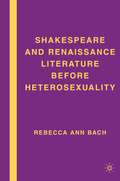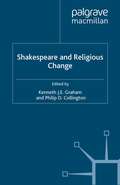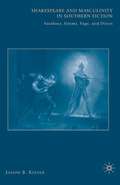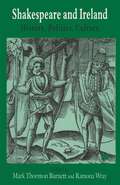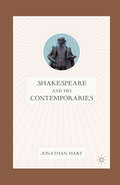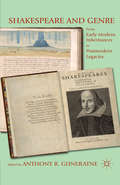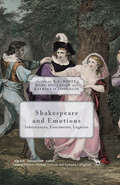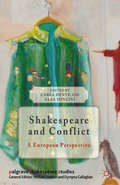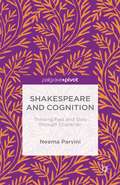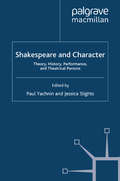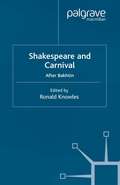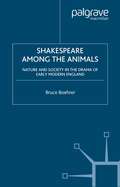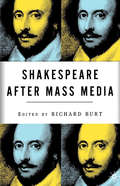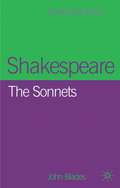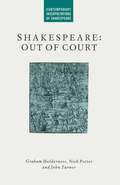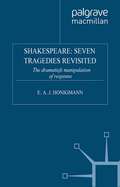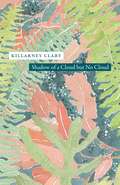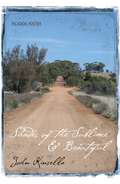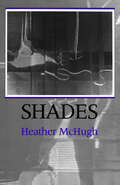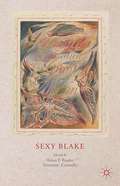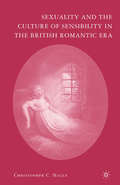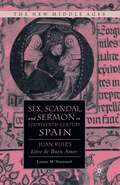- Table View
- List View
Shakespeare and Renaissance Literature before Heterosexuality
by R. BachShakespeare has been misread for centuries as having modern ideas about sex and gender.This book shows how in the Restoration and Eighteenth century, Shakespeare's plays and other Renaissance texts were adapted to make them conform to these modern ideas.Through readings of Shakespearean texts, including King Lear, Antony and Cleopatra, and Othello, and other Renaissance drama, the book reveals a sexual world before heterosexuality. Shakespeare and Renaissance Literature Before Heterosexuality shows how revisions and criticism of Renaissance drama contributed to the emergence of heterosexuality.It also shows how changing ideas about status, adultery, friendship, and race were factors in that emergence.
Shakespeare and Religious Change (Early Modern Literature in History)
by K. Graham P. CollingtonThis balanced and innovative collection explores the relationship of Shakespeare's plays to the changing face of early modern religion, considering the connections between Shakespeare's theatre and the religious past, the religious identities of the present and the deep cultural changes that would shape the future of religion in the modern world.
Shakespeare and Masculinity in Southern Fiction: Faulkner, Simms, Page, and Dixon
by J. KeenerThe book advances the idea that American, Southern, white, planter class authors have appropriated models and modes of masculinity from William Shakespeare. Keener traces the history of this appropriation and its attendant masculinities from authors as early as William Gilmore Simms, through Thomas Nelson Page and Thomas Dixon, to William Faulkner.
Shakespeare and Ireland: History, Politics, Culture
by Mark Thornton Burnett Ramona WrayShakespeare and Ireland examines the complex relationship between the most celebrated icon of the British establishment and Irish literary and cultural traditions. Addressing Shakespearean representations of Ireland as well as Irish writers' responses to the dramatist, it ranges widely across theatrical performances, pedagogical practices, editorial undertakings and political developments. The writings of Joyce, Heaney and Yeats are considered, in addition to recent nationalist discourses. In so doing, the collection establishes the multiple 'Shakespeares' and competing 'Irelands' that inform the Irish imagination.
Shakespeare and His Contemporaries
by J. HartThis book is concerned with language, genre, drama, and literary and historical narrative and examines the comedy of Shakespeare in the context of comedies from Italy, Spain, and France in the sixteenth and seventeenth centuries.
Shakespeare and Genre: From Early Modern Inheritances to Postmodern Legacies
by A. GuneratneProvides a comprehensive survey of approaches to genre in Shakespeare's work. Contributors probe deeply into genre theory and genre history by relating Renaissance conceptions. In this sense, the volume proposes to read Shakespeare through genre and, just as importantly, read genre through Shakespeare.
Shakespeare and Emotions: Inheritances, Enactments, Legacies (Palgrave Shakespeare Studies)
by R. S. White Mark Houlahan Katrina O’LoughlinThis collection of essays approaches the works of Shakespeare from the topical perspective of the History of Emotions. Contributions come from established and emergent scholars from a range of disciplines, including performance history, musicology and literary history.
Shakespeare and Conflict: A European Perspective (Palgrave Shakespeare Studies)
by Carla Dente and Sara SonciniWhat has been the role played by principles, patterns and situations of conflict in the construction of Shakespeare's myth, and in its European and then global spread? The fascinatingly complex picture that emerges from this collection provides new insight into Shakespeare's unique position in world literature and culture.
Shakespeare and Cognition: Thinking Fast and Slow through Character
by N. ParviniShakespeare and Cognition challenges orthodox approaches to Shakespeare by using recent psychological findings about human decision-making to analyse the unique characters that populate his plays. It aims to find a way to reconnect readers and watchers of Shakespeare's plays to the fundamental questions that first animated them. Why does Othello succumb so easily to Iago's manipulations? Why does Anne allow herself to be wooed by Richard III, the man who killed her husband and father? Why does Macbeth go from being a seemingly reasonable man to a cold-blooded killer? Why does Hamlet take so long to kill Claudius? This book aims to answer these questions from a fresh perspective.
Shakespeare and Character: Theory, History, Performance and Theatrical Persons (Palgrave Shakespeare Studies)
by P. Yachnin J. SlightsShakespeare and Character brings together leading scholars in theory, literary criticism, and performance studies in order to redress a serious gap in Shakespeare studies and to put character back at the centre of our understanding of Shakespeare's achievement as an artist and thinker.
Shakespeare and Carnival: After Bakhtin (Early Modern Literature in History)
by R. KnowlesThis collection of essays is the first to reassess a range of Shakespeare's plays in relation to carnivalesque theory. Contributors re-historicize the carnivalesque in different ways, offering both a developed application, or critique of, Bakhtin's thought.
Shakespeare Among the Animals: Nature and Society in the Drama of Early Modern England (Early Modern Cultural Studies 1500–1700)
by B. BoehrerShakespeare Among the Animals examines the role of animal-metaphor in the Shakespeare stage, particularly as such metaphor serves to underwrite various forms of social difference. Working through texts such as Shakespeare's Midsummer Night's Dream , Jonson's Volpone , and Middleton's A Chaste Maid in Cheapside , different chapters of the study focus upon the allegedly natural character of femininity, masculinity, and ethnicity, while a fourth chapter considers the nature of the natural world itself as it appears on the Renaissance stage. Addressing each of these topics in turn, Shakespeare Among the Animals explores the notions of cultural order that underlie early modern conceptions of the natural world, and the ideas of nature implicit in early modern social practice.
Shakespeare After Mass Media
by R. BurtShakespeare in mass media - particularly film, video, and television - is arguably the hottest, fastest growing research agenda in Shakespeare studies. Shakespeare after Mass Media provides students and scholars with the most comprehensive resource available on the market for studying the pop cultural afterlife of The Bard. From marketing to electronic Shakespeare, comics to romance novels, Star Trek to Branagh, radio and popular music to Bartlett's Quotations , the volume explores the contemporary cultural significance of Shakespeare in an unprecedently broad array of mass media contexts. With theoretical sophistication and accessible writing, it will be the ideal text for courses on Shakespeare and mass media.
Shakespeare: The Sonnets (Analysing Texts) (PDF)
by John BladesThe appearance in 1609 of Shakespeare's Sonnets is cloaked in mystery and controversy, while the poems themselves are masterpieces of silence and deception. The intervening four centuries have done little to diminish either their mystique or their appeal, and recent years have witnessed an upsurge in interest in these brilliant and contentious lyrics. John Blades' penetrating study of the Sonnets is a highly lucid introduction to Shakespeare's subjects and poetic craft, involving detailed insights on the major themes, together with a comprehensive exploration of the Rival Poet and Dark Mistress sequences.
Shakespeare: Dramatizations of Court Society (Contemporary Interpretations of Shakespeare)
by G. Holderness J. Turner N. PotterThis book examines six plays by Shakespeare (Love's Labour's Lost, Hamlet, As You Like It, Twelfth Night, The Winter's Tale, and The Tempest) as dramatizations of the Renaissance court in its developing history - a history searched by Shakespeare to disclose its most characteristic gains and losses. For these plays do not simply celebrate Tudor and Stuart rule: they scrutinize it too, in the centre of its institutional theatre of power, the court. This book shows how, if the plays came into the court, the court also came into the plays, with its most salient features - its competitiveness, its inner tensions and its contradictions, its language, its cultural life and its entertainments - exposed to the scrutiny of an art-form that proved itself to be a new mode of historical understanding.
Shakespeare: The Dramatist’s Manipulation of Response
by E. HonigmannThis classic text, reprinted several times since its first publication in 1976, has been extensively revised in this new edition and includes new chapters on Henry V, As You Like It, and on 'the study of the audience and the study of response'. Both readers and actors/theatre-goers will find will find it opens up new ways of looking at the plays and at the mechanisms that underpin some of the most magical moments in Shakespeare's plays.
Shadow of a Cloud but No Cloud (Phoenix Poets)
by Killarney ClaryShadow of a Cloud but No Cloud, the latest collection from enigmatic prose poet Killarney Clary, is a book-length sequence of unnumbered, untitled poems, each evoking a clear moment in time. The details on which Clary chooses to focus suggest a narrative that will not resolve. The unnamed people with whom she interacts offer exchanges she is desperate to prolong, and in attempts to understand her place, she reaches beneath the fragile armor of those loved, especially those who can no longer answer her. This quietly haunting book, remarkable for its subtlety and delicacy, is Clary’s strongest, most engaging work to date and amply shows her to be a master of this lyric genre.
Shadow of a Cloud but No Cloud (Phoenix Poets)
by Killarney ClaryShadow of a Cloud but No Cloud, the latest collection from enigmatic prose poet Killarney Clary, is a book-length sequence of unnumbered, untitled poems, each evoking a clear moment in time. The details on which Clary chooses to focus suggest a narrative that will not resolve. The unnamed people with whom she interacts offer exchanges she is desperate to prolong, and in attempts to understand her place, she reaches beneath the fragile armor of those loved, especially those who can no longer answer her. This quietly haunting book, remarkable for its subtlety and delicacy, is Clary’s strongest, most engaging work to date and amply shows her to be a master of this lyric genre.
Shadow of a Cloud but No Cloud (Phoenix Poets)
by Killarney ClaryShadow of a Cloud but No Cloud, the latest collection from enigmatic prose poet Killarney Clary, is a book-length sequence of unnumbered, untitled poems, each evoking a clear moment in time. The details on which Clary chooses to focus suggest a narrative that will not resolve. The unnamed people with whom she interacts offer exchanges she is desperate to prolong, and in attempts to understand her place, she reaches beneath the fragile armor of those loved, especially those who can no longer answer her. This quietly haunting book, remarkable for its subtlety and delicacy, is Clary’s strongest, most engaging work to date and amply shows her to be a master of this lyric genre.
Shadow of a Cloud but No Cloud (Phoenix Poets)
by Killarney ClaryShadow of a Cloud but No Cloud, the latest collection from enigmatic prose poet Killarney Clary, is a book-length sequence of unnumbered, untitled poems, each evoking a clear moment in time. The details on which Clary chooses to focus suggest a narrative that will not resolve. The unnamed people with whom she interacts offer exchanges she is desperate to prolong, and in attempts to understand her place, she reaches beneath the fragile armor of those loved, especially those who can no longer answer her. This quietly haunting book, remarkable for its subtlety and delicacy, is Clary’s strongest, most engaging work to date and amply shows her to be a master of this lyric genre.
Shades of the Sublime & Beautiful
by John KinsellaAustralian John Kinsella is one of the most highly regarded poets currently writing in English. Taking Edmund Burke’s 250-year old masterpiece A Philosophical Enquiry into the Origin of Our Ideas of the Sublime and Beautiful as his template, Kinsella has produced his most accomplished and broadly representative work to date. Shades of the Sublime & Beautiful is a warm, human, anecdotally rich book, concentrating many of the themes that have obsessed its author over the last twenty years: language, love, the invocation of place, the mysteries of the Australian wilderness, and our mediations between the human and natural realms. Together, these lyric meditations build towards a profound thesis on the ecology of the imagination, and are always conducted in concrete, vivid and exuberant language that is unmistakably Kinsella’s own. ‘Kinsella’s poems are a very rare feat: they are narratives of feeling. Vivid sight – of landscapes, of animals, of human forms in distant light – becomes insight. There is, often, the shock of the new. But somehow awaited, even familiar. Which is the homecoming of a true poet’ George Steiner ‘John Kinsella is an Orphic fountain, a prodigy of the imagination . . . he frequently makes me think of John Ashbery: improbable fecundity, eclecticism, and a stand that fuses populism and elitism in poetic audience’ Harold Bloom
Shades (Wesleyan Poetry Series)
by Heather McHughShades is a book of shadow and light cast between trees and sun, between day and room, between life and death. It acknowledges endings as beginnings; it offers compassion and tenderness, searching for hope in the richness of nature; it seeks the same resources within the human being.Heather McHugh's companion volume to To the Quick (Wesleyan 1987) continues the music and brilliance characteristic of her work but moves more deeply into the metaphysical. She writes in paradox, with serious wit and intensity, the crafted language of "stitches in hand and birds in time"; "We part/ before we part; indeed,/ we part before we meet…" She studies "going matched with coming." She begins with a series of elegies that bring sexuality and death into brutal juxtaposition. Living and dying are the occasions of these poems, the soul the ultimate concern. This poetry takes to heart the fundamental strangeness of being.
Sexy Blake
by Helen P. Bruder Tristanne ConnollyThis book lays bare numerous sexy Blakes, arguing for both chastity and pornography, violence and domination as well as desire and redemption, and also journeying in the realms of conceptual sex and conceptual art. Fierce tussles over the body in, and the body of, the poet-artist's work celebrate Blakean attractions and repulsions.
Sexuality and the Culture of Sensibility in the British Romantic Era
by C. NagleThis is the first study to fully trace the influence of Sensibility on British Romanticism. Sensibility continually found new forms of expression in the late Eighteenth and early Nineteenth century. Nagle explores how it coexisted and intermingled with Romanticism and revises the traditional narratives of literary periodization of this era.
Sex, Scandal, and Sermon in Fourteenth-Century Spain: Juan Ruiz's Libro de Buen Amor (The New Middle Ages)
by L. HaywoodThis book is an innovative study of humour and the body in Juan Ruiz's Libro de Buen Amor (1330), using modern analytical techniques to examine the place of the Libro's bawdy and grotesque in relation to secular and sacred culture.
